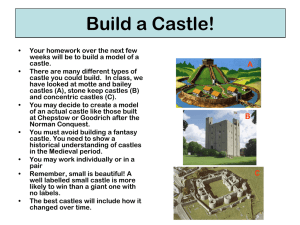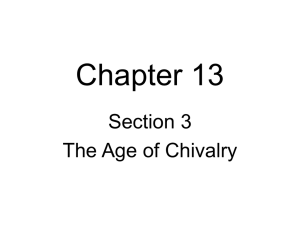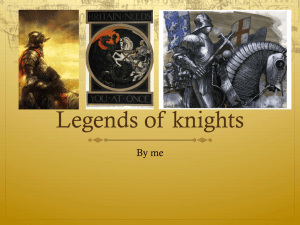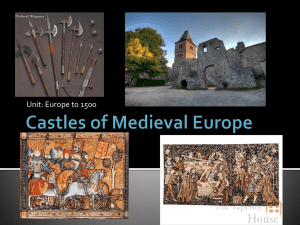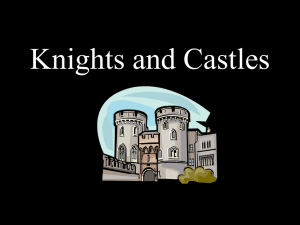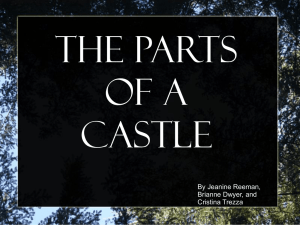Knights and Castles
advertisement
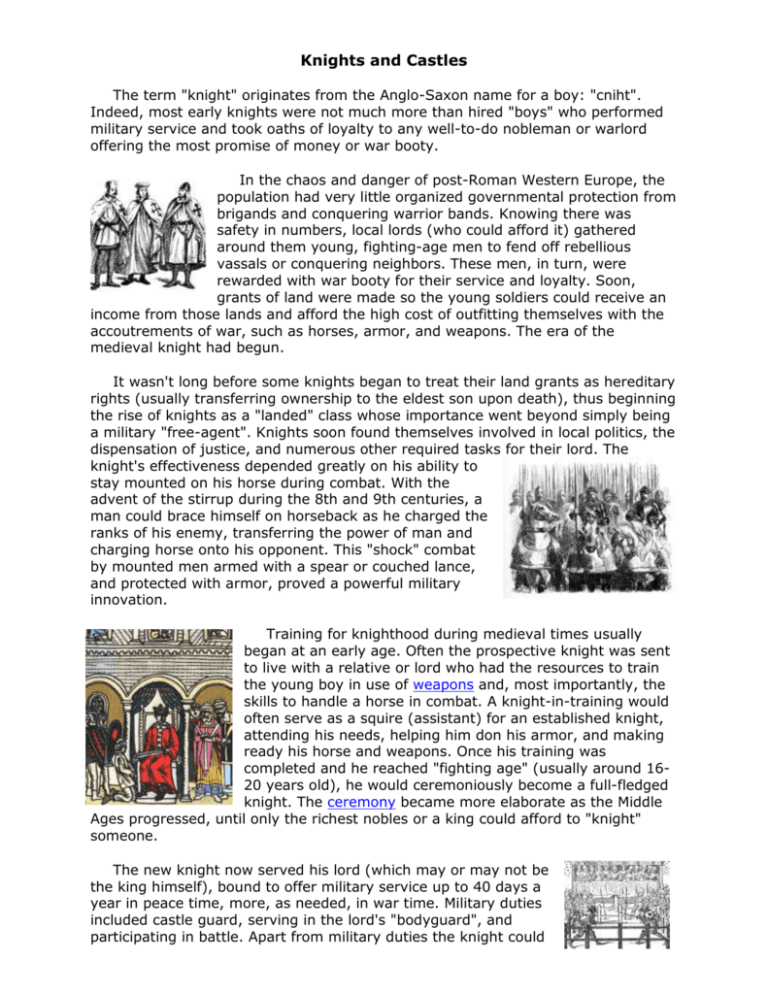
Knights and Castles The term "knight" originates from the Anglo-Saxon name for a boy: "cniht". Indeed, most early knights were not much more than hired "boys" who performed military service and took oaths of loyalty to any well-to-do nobleman or warlord offering the most promise of money or war booty. In the chaos and danger of post-Roman Western Europe, the population had very little organized governmental protection from brigands and conquering warrior bands. Knowing there was safety in numbers, local lords (who could afford it) gathered around them young, fighting-age men to fend off rebellious vassals or conquering neighbors. These men, in turn, were rewarded with war booty for their service and loyalty. Soon, grants of land were made so the young soldiers could receive an income from those lands and afford the high cost of outfitting themselves with the accoutrements of war, such as horses, armor, and weapons. The era of the medieval knight had begun. It wasn't long before some knights began to treat their land grants as hereditary rights (usually transferring ownership to the eldest son upon death), thus beginning the rise of knights as a "landed" class whose importance went beyond simply being a military "free-agent". Knights soon found themselves involved in local politics, the dispensation of justice, and numerous other required tasks for their lord. The knight's effectiveness depended greatly on his ability to stay mounted on his horse during combat. With the advent of the stirrup during the 8th and 9th centuries, a man could brace himself on horseback as he charged the ranks of his enemy, transferring the power of man and charging horse onto his opponent. This "shock" combat by mounted men armed with a spear or couched lance, and protected with armor, proved a powerful military innovation. Training for knighthood during medieval times usually began at an early age. Often the prospective knight was sent to live with a relative or lord who had the resources to train the young boy in use of weapons and, most importantly, the skills to handle a horse in combat. A knight-in-training would often serve as a squire (assistant) for an established knight, attending his needs, helping him don his armor, and making ready his horse and weapons. Once his training was completed and he reached "fighting age" (usually around 1620 years old), he would ceremoniously become a full-fledged knight. The ceremony became more elaborate as the Middle Ages progressed, until only the richest nobles or a king could afford to "knight" someone. The new knight now served his lord (which may or may not be the king himself), bound to offer military service up to 40 days a year in peace time, more, as needed, in war time. Military duties included castle guard, serving in the lord's "bodyguard", and participating in battle. Apart from military duties the knight could also participate in administering justice (as part of assizes--a medieval form of our modern juries), manage his estates (which was his prime source of income), and continue to hone his combat skills in tournament. The tournament in the early Middle Ages originated as a meleé, resembling actual combat in groups that could result in injuries or even death. Men were taken hostage and held for ransom, horses and armor confiscated by the captors. As lords and churchmen grew concerned over this senseless loss of life and resources, new regulations and safety measures were put into effect. The meleé was replaced by individual combat events (among them the joust), and new innovations in armor specifically designed for the tournament made it somewhat safer. Medieval tournaments were a great form of entertainment, enjoyed by both commoners and nobles. Dances and parties became standard nighttime activities once the ladies joined the spectators on a regular basis. A rich noble would sponsor a tournament and supply the purse for the prizes. It was a series of mounted and armored contests, in which a number of combatants compete and the one that prevailed through the final round or that finished with the best record was declared the winner and is awarded the prize. The joust became the centerpiece of all tournaments. It was an idealized form of knightly combat. In a joust, two knights charged each other, armed with a lance, the object being to use the lance to unhorse one's opponent. This event became the premier tournament event because of the dramatic effect of two mounted knights in full armor charging each other at full speed. These were pretty simple affairs. The two knights, separated by 100-300 yards of open space, would charge each other until one was unhorsed. From this came all the rules for awarding points and penalties for "unchivalrous" behavior (like hurting the horses or hitting the other fellow when his back was turned).Eventually, most jousts took place on what we now think of as "the lists." This was a field up to 100 yards wide and 300 yards long. Running down the middle of the lists was a five foot high wooden fence called "the tilt." The Knights Knights were not the only means of protection during the Middle Ages. Large stone castles were built in Europe from about the 1100’s to about the 1500’s. These huge buildings served not only to defend the country from foreign invaders but as the basic tool in preserving the king’s and the nobles’ power over the land. The castle was both a residence for the lord and his family, and a fortification. It was a strong place for the lord to defend himself against his enemies (and the king’s enemies, and his overlord’s enemies), a safe place for him and his knights to return to, and a place to live which emphasized his power. A few heavily armed knights could control a large area, if there was no organized army to go against them. Not only did knights fight against foreign enemies, they fought a lot against each other, and they put down rebellions among the peasants. Showing that you had a lot of power sometimes made actual fighting unnecessary. In Britain, many of the castles are along borders, to stop raids by the Welsh and the Scots, and as a basis for raiding in return. Stone and wood were about the only building materials available. Slate and thatch (bundles of reeds or other plants in a thick bundle) were used for roofs, but not for walls. Fortunately, northern Europe had large amounts of both wood and stone. Wood didn’t last as long, but, worse, it could be set on fire by the other side. Stone is very strong in compression (stone can hold up a great deal of weight). Mortar and gravity kept the stones in place. Once a stone building is constructed, it needs very little maintenance and lasts a long time. It is not, however, very pleasant to live in—a stone castle is cold, damp and dark. Many pieces were added to improve the castle as a residence. Part of the purpose of a castle was to be impressive, and to be an assertion of the lord’s power over the area. It also served as a warning to others who might want to take over that part of the land. Since a feudal lord was the vassal of the king, castles at key points in the landscape showed how powerful and in control the king was. Sometimes an entire castle was covered with a layer of whitewash to make it seem even more splendid, especially if it was on a hill, and seen from a distance. Pennants of bright colors, with the lord’s symbol, would fly over the towers. If a tournament or celebration was planned, bright flags might be hung from towers and doorways. The knights and their servants and their mounts all had to eat, as did the lord, his family, and his servants and officials, and their families. Many castles grew certain types of food inside their walls, to add variety to the diet of those inside the castle, but it was not nearly enough to feed the people in the castle, much less their guests. Castles might have beehives, herb gardens, fruit trees or a fishpond. Because the land inside the castle walls was not enough to feed all these people, they got their food from the peasants who farmed outside, and from hunting. There were restrictions on hunting by the peasants, and sometimes it was forbidden entirely, so that the lord and his retainers would have plenty of game to hunt. Hunting was also a major recreation for the lord and his men. Castles were built to keep out enemies. When an attack was expected, the drawbridge was raised, the gates and portcullis were closed, and archers were stationed on the towers. The walls were not only high, in a well-planned castle, but they were arranged as much as possible so that anyone climbing the walls could be shot at from two directions. Many castles have strange shapes because the castle was designed to accommodate the terrain, and to catch attackers in a cross fire. The castle’s defenses invited a great deal of ingenuity from the attackers. Rolling wooden towers, covered with thick hides to stop arrows and kept wet so they could not be set on fire, were brought up to the walls in an attack. Sometimes they even worked. Catapults threw heavy stones at the walls to make a breach or loads of rocks (or diseased livestock, or fire bombs) over the walls. The battering ram—generally used against a door—was an old favorite. Thoughts of different ‘siege engines’ were always on the minds of the castles’ designers. The castle was often built on a raised platform. Roads to the castle angled and sloped to restrict the easy use of battering rams and the like. There was often also the traditional moat (left behind from digging out the earth to make the raised platform for the castle) and drawbridge, just to keep things interesting. Another method of defeating a castle was laying siege to it, by trying to starve out the inhabitants, or waiting until they ran out of water. If their water could be poisoned, they had to surrender. A good well was extremely important to a castle. The use of gunpowder made both castles and city walls much more vulnerable, because cannon could knock down the stone walls. Before gunpowder, about the only way to bring down a stone wall was the undermine it, that is, to dig a hole under it. This would cause a portion of the wall to collapse into the hole beneath it. This kind of digging was difficult, especially since the inhabitants of the castle would be fighting to keep their enemies from doing it. (Pouring boiling water on them, shooting at them with arrows, trying to set the shelter they had built over themselves on fire—the usual). Some castles, or parts of castles, were built on solid rock, so they could not be undermined. After gunpowder and cannons became available, there was less point to a castle as a fortification Castles
